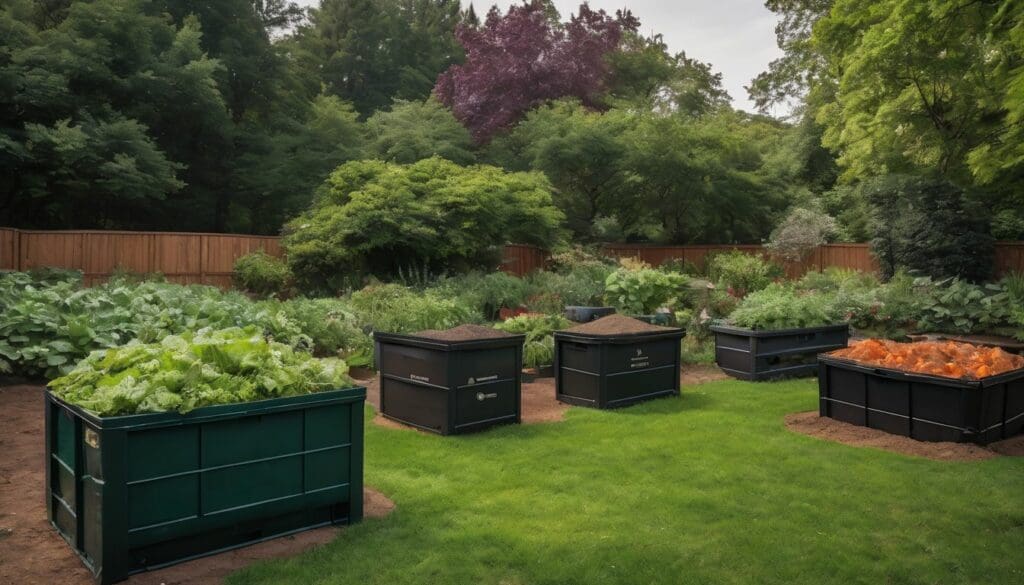Schools everywhere are looking for ways to be kinder to our planet. It’s a fact: eco-friendly schools can help combat climate change and reduce waste. This article will explore simple yet effective green initiatives that your school can adopt, offering multiple benefits.
Let’s make a difference together!
Key Takeaways
- Schools adopting eco – friendly initiatives help fight climate change, reduce waste, and bring health benefits through outdoor activities and healthier food options.
- Initiatives like planting native species, creating habitats, composting programs, meat – free Mondays, sustainable food purchasing, and reducing food waste teach students about sustainability while saving costs for schools.
- Promoting alternative transportation to school along with the use of energy-efficient lighting and water-conserving fixtures lowers schools’ carbon footprint and operational expenses.
- Implementing creative recycling projects and using environmentally friendly cleaning supplies reduce schools’ environmental impact and foster a culture of sustainability among the school community.
- Eco-friendly practices within schools result in improved student performance as they provide hands-on learning experiences that enhance engagement and academic achievement.
Importance of Eco-Friendly Initiatives for Schools
Transitioning from the broader overview, it’s crucial to delve into why adopting eco-friendly school initiatives is not merely a trend but a necessity. These green school programs foster an educational environment where sustainability and environmental responsibility are at the core of learning and everyday operations.
They set the stage for students to become eco-conscious individuals who understand the impact of their actions on the planet.
Incorporating sustainable practices within schools has ripple effects that extend beyond classroom walls. It teaches young minds about resource conservation, equipping them with knowledge for making environmentally responsible decisions.
Furthermore, implementing earth-friendly educational efforts like meat-free days at school or using energy-efficient lighting can lead to significant cost savings over time. Such initiatives also bring health benefits as they often encourage outdoor activities and healthier eating options in cafeterias.
Eco-conscious classroom practices aren’t just theoretical; they instigate real change by reducing carbon footprints and nurturing biodiversity on school grounds. Through active engagement with climate-friendly school initiatives, future generations learn critical problem-solving skills related to environmental challenges, seeding a more sustainable education across society.
Encouraging Biodiversity in School Spaces
Schools can encourage biodiversity by planting native species, creating habitats and implementing composting programs. These initiatives not only benefit the environment but also provide valuable hands-on learning opportunities for students.
Planting native species
To enhance biodiversity in school spaces, planting native species is crucial. By incorporating indigenous plants into the school landscape, it creates a more sustainable ecosystem that supports local wildlife and reduces water consumption.
Moreover, native species help to control pests naturally, reducing the need for harmful chemical pesticides. This initiative also serves as a valuable educational opportunity for students to learn about the importance of preserving local ecosystems and promoting environmental stewardship.
Encouraging the growth of native species at schools can significantly contribute to creating a more eco-friendly environment. It provides numerous benefits such as supporting local wildlife habitats, conserving water resources and offering educational opportunities for students on environmental conservation efforts.
Creating habitats
Schools can encourage biodiversity by creating habitats through planting native species, establishing wildlife gardens, and incorporating bird boxes and insect hotels. This empowers students to engage with nature while fostering a sense of environmental responsibility.
By composting organic waste on school grounds, students actively participate in the natural recycling process and learn the value of reducing waste.
Implementing eco-friendly cleaning supplies ensures that school facilities remain free from harsh chemicals, safeguarding the environment and the health of all students. Choosing products made from sustainable materials contributes to a greener future while providing an educational opportunity for students to understand responsible consumption.
Composting
Schools can make a significant impact on the environment by implementing composting programs. Students and staff can contribute to reducing waste by composting food scraps, paper products, and organic materials.
Composting not only reduces the amount of waste sent to landfills but also produces nutrient-rich soil that can be used for school gardens and landscaping projects.
Encouraging a culture of composting in schools promotes environmental awareness and helps reduce the carbon footprint associated with waste disposal. Through active participation in composting initiatives, schools can instill eco-friendly habits in students while contributing positively to the local ecosystem.
Improving School Cafeteria Sustainability
Introducing initiatives such as Meat-free Mondays, sustainable food purchasing, and reducing food waste can significantly improve the sustainability of school cafeterias. To learn more about how eco-friendly school initiatives can make a positive impact, keep reading.
Meat-free Mondays
Schools are implementing “Meat-free Mondays” to reduce the environmental impact of food consumption. By offering plant-based meals, schools promote sustainable and eco-friendly practices among students.
This initiative aligns with environmentally conscious individuals‘ efforts to support conservation and reduce their carbon footprint.
The introduction of Meat-free Mondays in school cafeterias encourages students to explore alternative sources of protein while raising awareness about the benefits of reducing meat consumption for both personal health and the environment.
Sustainable food purchasing
Schools can make a significant impact by prioritising sustainable food purchasing. This involves sourcing locally grown and organic produce, reducing food miles, and supporting ethical farming practices.
By choosing eco-friendly options for school meals, such as fruits and vegetables in season, schools contribute to environmental conservation efforts while also promoting healthier eating habits among students.
Additionally, schools can focus on using biodegradable or reusable packaging to minimise waste generated from cafeteria operations. By implementing these initiatives, schools actively support the shift towards a more sustainable and environmentally friendly food system.
Reducing food waste
Schools can reduce food waste by implementing strategies such as monitoring portion sizes, encouraging students to take only what they will eat, and repurposing leftovers into new meals.
By composting organic waste and donating surplus food to local charities, schools can significantly minimise their environmental impact and contribute to a more sustainable community.
Engaging students in educational programmes about the consequences of food waste, and involving them in planning sustainable menus, are effective ways for schools to instil environmentally conscious practices from an early age.
Encouraging Energy and Water Conservation
Schools can encourage energy and water conservation by promoting alternative transportation, conserving energy through lighting and appliances, and using efficient fixtures to reduce water consumption.
These initiatives not only benefit the environment but also teach students the importance of sustainable practices.
Promoting alternative transportation
Encouraging students to use bicycles, walk, or take public transport reduces carbon emissions and traffic congestion. Providing secure bike storage and locker facilities makes cycling a convenient choice for commuting, fostering a culture of sustainability within the school community.
Implementing carpool programs helps reduce pollution and fuel consumption, contributing to a cleaner local environment.
Educating students about the environmental impact of transportation choices empowers them to make eco-friendly decisions. By promoting alternative transportation options such as walking or biking, schools can actively contribute to reducing their carbon footprint and creating a greener future for all.
Conserving energy through lighting and appliances
Schools can conserve energy by using energy-efficient lighting and appliances. Energy-saving light bulbs, such as LEDs, require less power than traditional incandescent bulbs, reducing electricity usage and costs.
Additionally, using energy-efficient appliances in school kitchens and classrooms contributes to reduced energy consumption. This proactive approach aligns with eco-friendly school initiatives while also promoting sustainability.
Incorporating smart technology into school buildings is an effective way to reduce energy usage from lighting and appliances. Automated lighting systems equipped with motion sensors can ensure lights are only on when needed, cutting down on unnecessary electricity consumption.
Conserving water through efficient fixtures
Schools can conserve water through efficient fixtures. Installing low-flow taps, toilets and showers significantly reduces water consumption. These eco-friendly measures not only benefit the environment but also decrease utility costs for schools.
By promoting the use of water-efficient fixtures, schools contribute to sustainability while saving resources.
In addition, rainwater harvesting systems can further enhance a school’s efforts in conserving water. These systems collect rainwater from rooftops and store it for later use in irrigation or flushing toilets, reducing reliance on municipal water supplies.
Promoting Waste Reduction and Recycling
Promoting waste reduction and recycling in schools is crucial for creating a sustainable environment. By implementing eco-friendly cleaning supplies, reducing paper waste, and encouraging creative recycling projects, schools can significantly reduce their environmental impact.
Reducing paper waste
Schools can reduce paper waste by implementing digital communication methods and encouraging double-sided printing. Encouraging students to submit assignments electronically and using online platforms for announcements helps to minimise paper usage.
Educating students about the importance of reducing paper waste and promoting responsible printing habits fosters a culture of sustainability within the school community. Implementing a paper recycling programme allows schools to repurpose used paper, contributing to environmental conservation efforts while also reducing the amount of waste sent to landfills.
By using digital communication methods and educating students about responsible printing habits, schools can significantly reduce their paper waste output and contribute positively towards sustainable environmental practices.
Implementing creative recycling projects
Schools can implement creative recycling projects to minimise waste and promote environmental responsibility. Students can participate in upcycling workshops, turning old materials into new creations like artwork or practical items.
Eco-friendly competitions such as designing innovative recycled products can engage and educate students on the benefits of recycling. Waste segregation initiatives in schools encourage responsible disposal of materials, while setting up collection points for used electronics, batteries, and clothing supports sustainable practices within the school community.
Encouraging students to get involved with creating eco-bricks from plastic waste fosters a sense of ownership over environmental efforts. Setting up a ‘waste-to-craft’ club where students repurpose various materials into useful items nurtures creativity while reducing landfill impact.
Using eco-friendly cleaning supplies
Schools can enhance their eco-friendly initiatives by using cleaning supplies that are environmentally friendly. These products are made from natural and non-toxic ingredients, reducing the use of harmful chemicals in school environments.
Eco-friendly cleaning supplies also help to minimise air and water pollution, contributing to a healthier and more sustainable learning environment for students.
Implementing eco-friendly cleaning supplies supports green school programmes, promoting environmental responsibility and sustainability among students and staff. By incorporating these products into daily maintenance routines, schools demonstrate their commitment to reducing their carbon footprint while providing a safer and greener educational setting for everyone involved.
The Impact of Eco-Friendly Schools
Eco-friendly schools lead to improved student performance, cost savings, and positive effects on the environment. Embrace a greener future for schools by reading more about the impact of eco-friendly initiatives in our blog.
Improved student performance
Eco-friendly school initiatives have been shown to enhance student performance. Students in environmentally conscious schools display increased engagement and academic achievement, driven by a holistic approach to education that emphasises sustainability and environmental responsibility.
By integrating green technology, sustainable classroom practices, and eco-friendly educational programmes into the curriculum, students develop critical thinking skills and a strong sense of environmental stewardship.
Furthermore, exposure to eco-conscious school policies and earth-friendly projects encourages students to become environmentally responsible citizens who are passionate about conservation efforts and take positive action towards protecting the planet.
Cost savings
Not only do eco-friendly school initiatives improve student performance, they also bring about significant cost savings. By implementing energy and water conservation measures, schools can significantly reduce utility bills.
Conserving energy through efficient lighting and appliances not only reduces the environmental impact but also lowers operational costs. Additionally, promoting waste reduction and recycling helps in cutting down on disposal expenses by minimising the amount of waste sent to landfills.
Moreover, optimising cafeteria sustainability practices such as reducing food waste and adopting sustainable food purchasing methods contribute to financial savings while supporting environmental efforts.
Encouraging biodiversity in school spaces also yields monetary benefits by reducing maintenance costs through natural landscaping solutions such as planting native species and creating habitats that require less upkeep than traditional landscaped areas.
Positive effects on the environment
Eco-friendly school initiatives have a positive effect on the environment by reducing the carbon footprint. Implementing green technology and sustainable practices helps to lower energy consumption, decrease waste production, and minimise water usage.
These efforts contribute to cleaner air, improved biodiversity, and reduced strain on natural resources.
Green school initiatives also promote environmental education and awareness, inspiring students to become advocates for conservation. By integrating eco-friendly practices into the curriculum and daily operations, schools create a ripple effect that extends beyond their walls, encouraging future generations to prioritise sustainability in all aspects of life.
Conclusion: Embracing a Greener Future for Schools
In conclusion, schools can make a significant impact by adopting eco-friendly initiatives. Students and staff participating in biodiversity projects foster a sense of responsibility towards the environment.
By implementing sustainability measures like meat-free days and energy conservation, schools contribute to a more sustainable future. The positive effects on student performance and cost savings further emphasise the importance of embracing green practices in educational institutions.
FAQs
1. What are eco-friendly school initiatives?
Eco-friendly school initiatives are practices and programs that schools adopt to be more environmentally responsible, like using green technology, having meat-free dining options, and teaching students about sustainable living.
2. How do these initiatives impact the environment?
These earthfriendly educational efforts reduce waste, save energy, and teach children how to care for our planet through ecoconscious classroom activities and climatefriendly school policies.
3. Can students get involved in environmental change at school?
Yes! Student activism for environmental change is a huge part of eco-conscious school practices; kids can lead sustainability projects or help set up eco-aware events.
4. Do eco-friendly ideas only apply inside the classroom?
No way! Green curriculum initiatives stretch beyond the classroom walls—schools can also include environmentalfriendly products in their supplies list and introduce sustainable education programs campus-wide.
5. Why should schools incorporate green technology into their daily routines?
By bringing in green technology for education purposes, schools ensure they’re staying up-to-date with modern teaching methods while promoting an environmentally friendly learning space.





